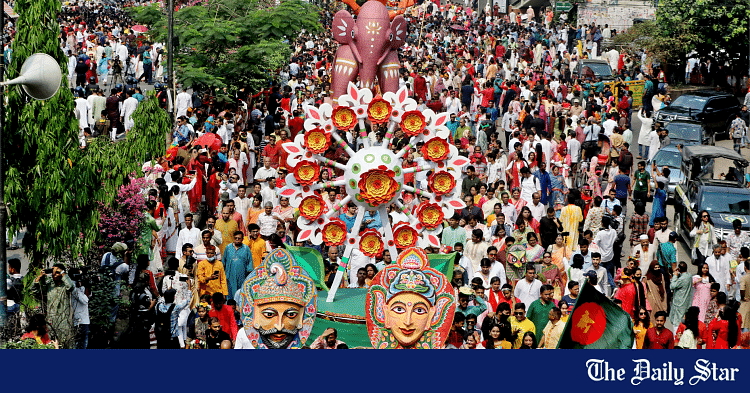Saif
Senior Member
- Jan 24, 2024
- 11,408
- 6,387
- Origin

- Residence

- Axis Group

Welcome Naboborsho
Published :
Apr 13, 2025 22:00
Updated :
Apr 13, 2025 22:00

Today's crimson glow of the eastern sky is special as it marks the dawning of the Bangla New Year 1432. Ingrained in the Bangalee ethos, the Pahela Boishakh is a highly cherished occasion. It is festival time as well as a time for starting afresh after the solemn observance of Chaitra Sangkranti - the day of bidding farewell of the year that was. The nation stands ready to welcome the New Year with renewed spirit. In the capital, the Chhayanaut's early morning musical programme at Ramna Batamul has become synonymous with the Pahela Boishakh celebration. Colourful processions from the Faculty of Fine Arts, University of Dhaka lends the celebration a visual diversity with its roots embedded in the country's traditional folk art and culture with a tinge of political satire.
Traditionally, though, Baisakhi fairs, poetry recitation and musical soirees made the day special. This year the festivities are set to become even more inclusive and vibrant. To its credit, the government has instructed all educational institutions, including madrashas, to organise programmes marking both Chaitra Sangkranti and Pahela Boishakh. Additionally, elaborate arrangements have been made to celebrate the day at the national level with the inclusion of ethnic communities such as the Chakma, Marma, Tripura, and Garo. These initiatives will showcase the rich cultural diversity of the nation.
The customary celebration of Pahela Boishakh dates back to the reign of the great Mughal Emperor Akbar. All the subjects of the emperor were required to pay their taxes by the final day of 'Choitra,' the last month on Bangla calendar. So that fresh calculation could start from the 1st day of the New Year. So, the festival is rooted in the agricultural life of the Bangalees. The common people in villages still reckon dates, months and seasons by the Bengali calendar, which is farmer-friendly and aptly reflects the agricultural cycle.
With traders, wholesalers, and jewellers showing greater enthusiasm about observing Haalkhata, the occasion of settling old accounts and opening new ledgers, the Pahela Boishakh marked a new commerce and economic cycle. The fairs arranged on the occasion of Pahela Boishakh turned into a community bonhomie apart from serving as an opportunity for procuring their household tools and other instruments. With improved communication, villages no longer have to wait for the annual fairs for procurement of such tools and instruments. Thus the Boishakhi fairs have lost their appeal to the villagers. Yet Boishakhi economy gets a boost because of certain must-do rituals including purchase of new dress and sweetmeat. The day's traditional fervour can further be enhanced by arranging musical soirees and recitation programmes as part of the celebration in every village. Thus it can help create a bond between and among people of the local community.
That said, the country has passed a landmark year in 1431 and is poised to build a reformed, new Bangladesh. But detractors misinterpret the aesthetic beauty and value of musical programmes and colourful processions. Malevolent oppositions cast an ominous shadow on this secular observance. Yet, the nation must remain hopeful that the good is sure to triumph over the evil. In the words of Rabindranath Tagore, it is hoped that "Boishakh, with its ascetic breath, will dust away that which is dying; the refuse and remnants of the bygone year would be gone, all weariness and infirmity would be wiped away, and the earth would gain purity bathed in fire."
Shuvo Naboborsho to all!
Published :
Apr 13, 2025 22:00
Updated :
Apr 13, 2025 22:00
Today's crimson glow of the eastern sky is special as it marks the dawning of the Bangla New Year 1432. Ingrained in the Bangalee ethos, the Pahela Boishakh is a highly cherished occasion. It is festival time as well as a time for starting afresh after the solemn observance of Chaitra Sangkranti - the day of bidding farewell of the year that was. The nation stands ready to welcome the New Year with renewed spirit. In the capital, the Chhayanaut's early morning musical programme at Ramna Batamul has become synonymous with the Pahela Boishakh celebration. Colourful processions from the Faculty of Fine Arts, University of Dhaka lends the celebration a visual diversity with its roots embedded in the country's traditional folk art and culture with a tinge of political satire.
Traditionally, though, Baisakhi fairs, poetry recitation and musical soirees made the day special. This year the festivities are set to become even more inclusive and vibrant. To its credit, the government has instructed all educational institutions, including madrashas, to organise programmes marking both Chaitra Sangkranti and Pahela Boishakh. Additionally, elaborate arrangements have been made to celebrate the day at the national level with the inclusion of ethnic communities such as the Chakma, Marma, Tripura, and Garo. These initiatives will showcase the rich cultural diversity of the nation.
The customary celebration of Pahela Boishakh dates back to the reign of the great Mughal Emperor Akbar. All the subjects of the emperor were required to pay their taxes by the final day of 'Choitra,' the last month on Bangla calendar. So that fresh calculation could start from the 1st day of the New Year. So, the festival is rooted in the agricultural life of the Bangalees. The common people in villages still reckon dates, months and seasons by the Bengali calendar, which is farmer-friendly and aptly reflects the agricultural cycle.
With traders, wholesalers, and jewellers showing greater enthusiasm about observing Haalkhata, the occasion of settling old accounts and opening new ledgers, the Pahela Boishakh marked a new commerce and economic cycle. The fairs arranged on the occasion of Pahela Boishakh turned into a community bonhomie apart from serving as an opportunity for procuring their household tools and other instruments. With improved communication, villages no longer have to wait for the annual fairs for procurement of such tools and instruments. Thus the Boishakhi fairs have lost their appeal to the villagers. Yet Boishakhi economy gets a boost because of certain must-do rituals including purchase of new dress and sweetmeat. The day's traditional fervour can further be enhanced by arranging musical soirees and recitation programmes as part of the celebration in every village. Thus it can help create a bond between and among people of the local community.
That said, the country has passed a landmark year in 1431 and is poised to build a reformed, new Bangladesh. But detractors misinterpret the aesthetic beauty and value of musical programmes and colourful processions. Malevolent oppositions cast an ominous shadow on this secular observance. Yet, the nation must remain hopeful that the good is sure to triumph over the evil. In the words of Rabindranath Tagore, it is hoped that "Boishakh, with its ascetic breath, will dust away that which is dying; the refuse and remnants of the bygone year would be gone, all weariness and infirmity would be wiped away, and the earth would gain purity bathed in fire."
Shuvo Naboborsho to all!










